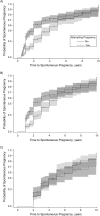"Research on Infertility: Definition Makes a Difference" Revisited
- PMID: 28633422
- PMCID: PMC5860354
- DOI: 10.1093/aje/kwx240
"Research on Infertility: Definition Makes a Difference" Revisited
Abstract
In a 1989 paper, Marchbanks et al. (Am J Epidemiol. 1989;130(2):259-267) noted inconsistent definitions of infertility across research and clinical practice and examined differences in prevalence estimates across definitions. Since their study, there have been substantial changes in society, technology, and clinical practice related to female reproductive health. In response, we revisited the original paper using data from a recent study among reproductive-aged women. Internal comparisons across various definitions of infertility were made by assessing how many and which women were classified as infertile, their age at infertility, and the probability of spontaneous pregnancy after infertility. Results were also compared with Marchbanks et al. Black women were more likely to be classified as infertile than white women based on the definition "12 months of unprotected intercourse" (40.1% vs. 33.7%) but less likely by "12 months of attempting pregnancy" (14.3% vs. 21.8%) and "visiting a doctor for help getting pregnant" (8.4% vs. 19.7%). After unprotected intercourse for 12 months, 36.1% of women who were attempting pregnancy spontaneously conceived by 6 months compared with 13.5% of women who were not attempting pregnancy. While our results for most infertility definitions were similar to those of Marchbanks et al., prevalence estimates continued to differ across demographic groups by definition.
Keywords: attempting pregnancy; demography; diagnosis; infertility; reproduction; unprotected intercourse; women’s health.
© The Author(s) 2017. Published by Oxford University Press on behalf of the Johns Hopkins Bloomberg School of Public Health. All rights reserved. For permissions, please e-mail: journals.permissions@oup.com.
Figures

References
-
- Marchbanks PA, Peterson HB, Rubin GL, et al. . The Cancer and Steroid Hormone Study Group Research on infertility: definition makes a difference. Am J Epidemiol. 1989;130(2):259–267. - PubMed
-
- Zegers-Hochschild F, Adamson GD, de Mouzon J, et al. . International Committee for Monitoring Assisted Reproductive Technology (ICMART) and the World Health Organization (WHO) revised glossary of ART terminology, 2009. Fertil Steril. 2009;92(5):1520–1524. - PubMed
-
- Speroff L, Fritz MA. Clinical Gynecologic Endocrinology and Infertility. Philadelphia, PA: Lippincott Williams & Wilkins; 2005.
-
- Solomon CG, Hu FB, Dunaif A, et al. . Menstrual cycle irregularity and risk for future cardiovascular disease. J Clin Endocrinol Metab. 2002;87(5):2013–2017. - PubMed
Publication types
Grants and funding
LinkOut - more resources
Full Text Sources
Other Literature Sources
Molecular Biology Databases

